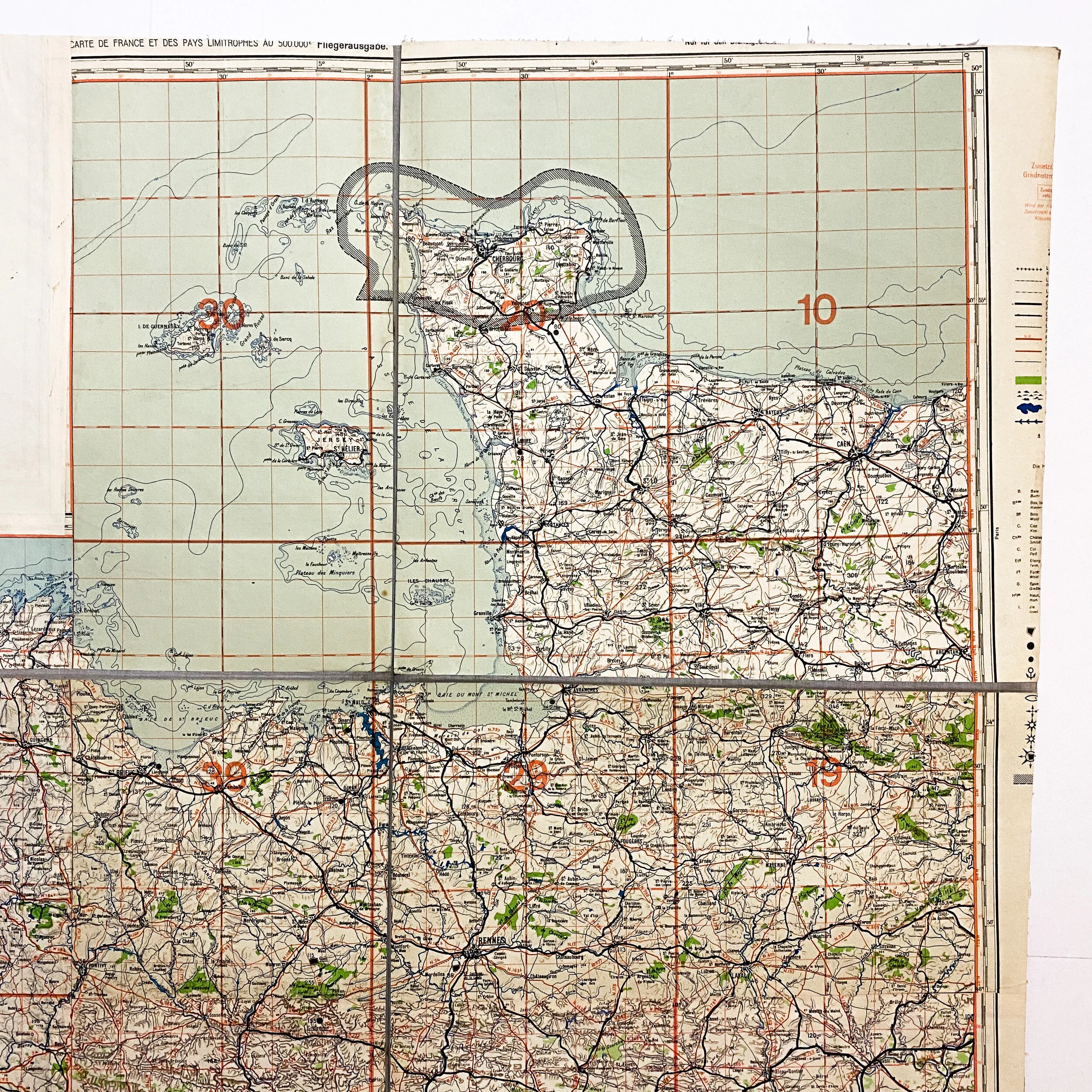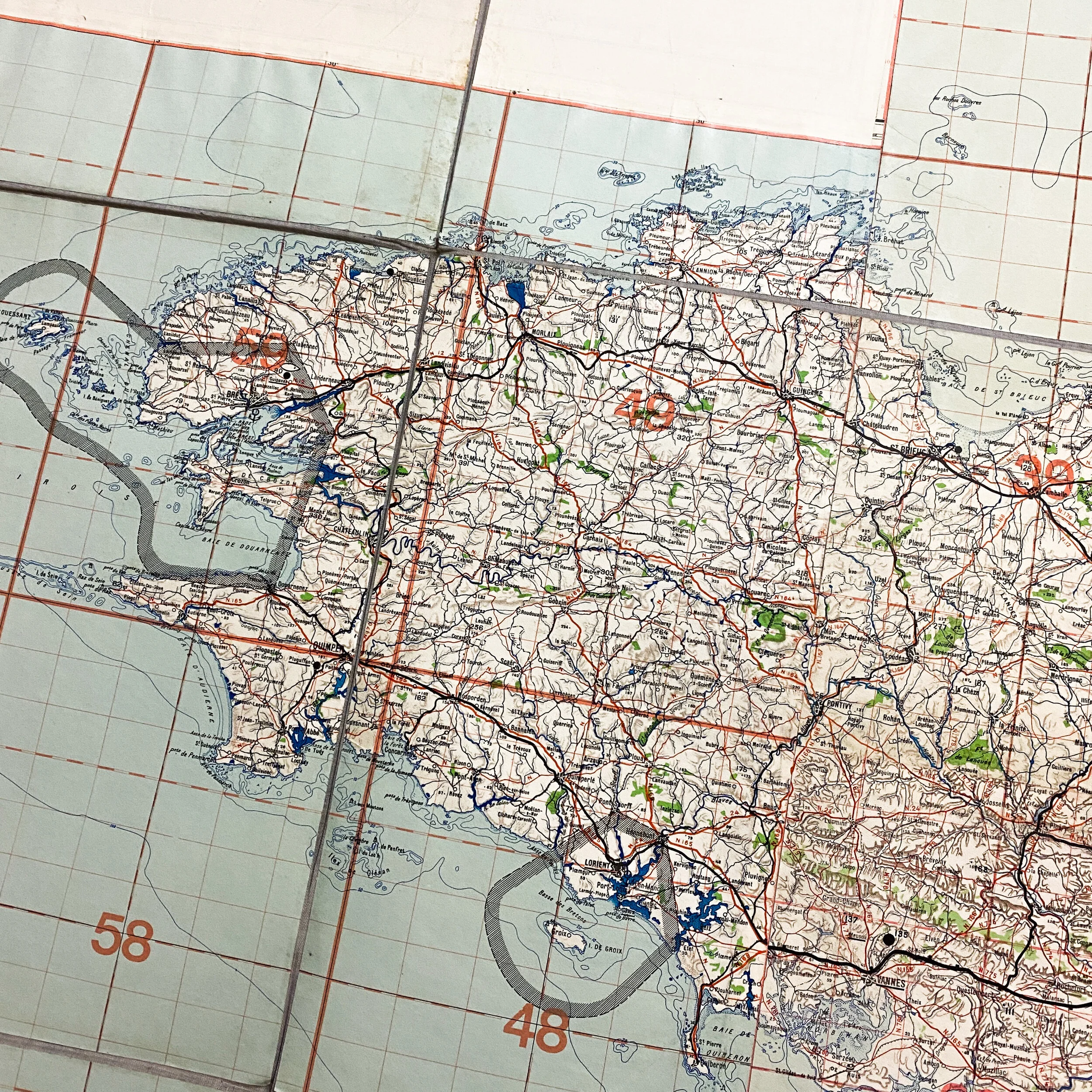German Named Staff Sargent Moritz Cherbourg D-Day Luftwaffe Aviator Map
















German Named Staff Sargent Moritz Cherbourg D-Day Luftwaffe Aviator Map
Measures a large 35.5 inches by 35.5 inches.
Rare original WWII Luftwaffe map owed and used by a German Staff Sargent (Feldwalbe) named Moritz. His name is written on the backside linen fold of the map which makes this map very unique. Many German maps were not inscribed by the name of the German soldier. The Normandy air map itself is printed on a heavy duty paper where it is attached to a cloth-like folded linen board. Maps such as this style were common for Luftwaffe soldier as they carried them with them in their bombers and aircraft during missions. This map shows a zoomed out view of the Normandy beaches stormed by the Allies on D-Day and also shows the German port city of Cherbourg very close to the initial Normandy landings on D-Day.
Battle of Cherbourg:
The Battle of Cherbourg was part of the Battle of Normandy during World War II. It was fought immediately after the successful Allied landings on June 6, 1944. Allied troops, mainly American, isolated and captured the fortified port, which was considered vital to the campaign in Western Europe, in a hard-fought, month-long campaign. When they drew up their plans for the invasion of France, the Allied staff considered that it would be necessary to secure a deep-water port to allow reinforcements to be brought directly from the United States. (Without such a port, equipment packed for transit would first have to be unloaded at a port in Great Britain, unpacked, waterproofed and then reloaded onto landing craft to be transferred to France). Cherbourg, at the end of the Cotentin Peninsula, was the largest port accessible from the landings.
The Allied planners decided at first not to land directly on the Cotentin Peninsula, since this sector would be separated from the main Allied landings by the Douve River valley, which had been flooded by the Germans to deter airborne landings. On being appointed overall land commander for the invasion in January 1944, British Army General Bernard Montgomery reinstated the landing on the Cotentin peninsula, partly to widen the front and therefore prevent the invaders becoming sealed into a narrow lodgement, but also to enable a rapid capture of Cherbourg.
On June 18, the US 9th Infantry Division reached the west coast of the peninsula, isolating the Cherbourg garrison from any potential reinforcements. Within 24 hours, the 4th Infantry, 9th and 79th Infantry Divisions were driving north on a broad front. There was little opposition on the western side of the peninsula and on the eastern side, the exhausted defenders around Montebourg collapsed. Several large caches of V-1 flying bombs were discovered by the Americans in addition to a V-2 rocket installation at Brix.
In two days, the American divisions were within striking distance of Cherbourg. The garrison commander, Lieutenant General Karl-Wilhelm von Schlieben, had 21,000 men but many of these were hastily drafted naval personnel or from labour units.[citation needed] The fighting troops who had retreated to Cherbourg (including the remnants of von Schlieben's own division, the 709th), were tired and disorganized. Food, fuel and ammunition were short. The Luftwaffe dropped a few supplies, but these were mostly items such as Iron Crosses, intended to bolster the garrison's morale.[citation needed] Nevertheless, von Schlieben rejected a summons to surrender and began carrying out demolitions to deny the port to the Allies.
Collins launched a general assault on June 22. Resistance was stiff at first, but the Americans slowly cleared the Germans from their bunkers and concrete pillboxes. Allied naval ships bombarded fortifications near the city on June 25. On June 26, the British elite force No. 30 Commando also known as 30 Assault Unit launched an assault on Octeville – a suburb to the south west of Cherbourg. This was the location of the Kriegsmarine naval intelligence HQ at Villa Meurice which the Commandos captured along with 20 officers and 500 men. On the same day the 79th Division captured Fort du Roule, which dominated the city and its defenses. This finished any organized defense. Von Schlieben was captured. The harbor fortifications and the arsenal surrendered on June 29, after a ruse by Allied officers, Capt Blazzard and Col Teague, who convinced the German officers to surrender the peninsula, bluffing about their manpower and ordnance. Some German troops cut off outside the defenses held out until July 1.